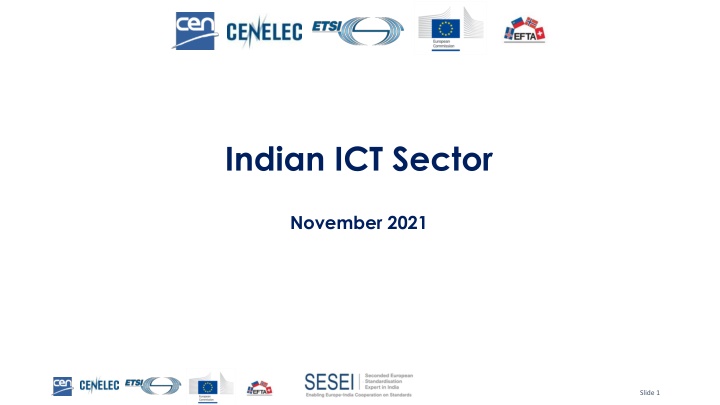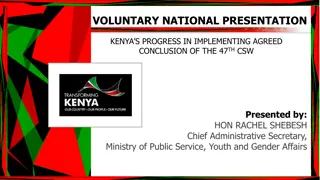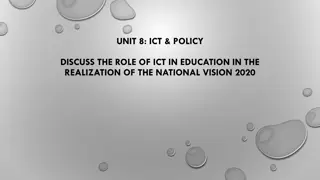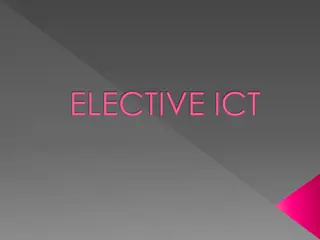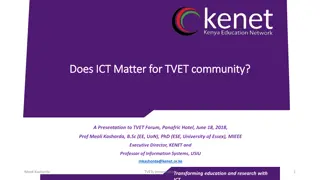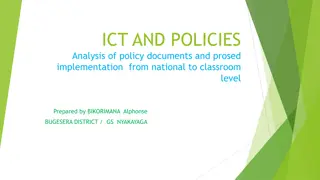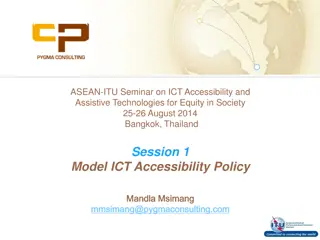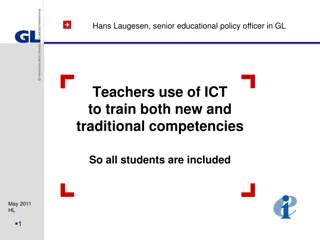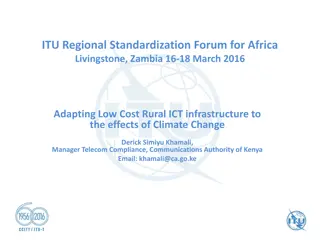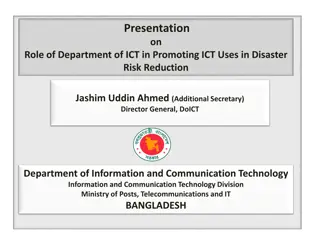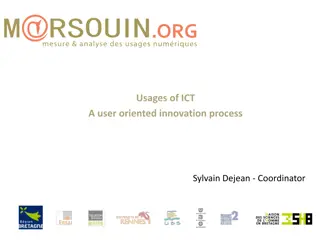Indian ICT Sector
The Indian ICT sector encompasses Information Technology and Telecom industries, highlighting market status, major players, growth drivers, and government policy initiatives. It discusses Indian Standardisation Bodies like BIS, TSDSI, and TEC, providing insights into the IT and Telecom industries and their significant components. The sector's market size, employment generation, revenue projections, and key technology areas for focus are also detailed. Government initiatives to attract foreign investment and predicted power demand by data centers reflect the sector's growth potential.
Download Presentation

Please find below an Image/Link to download the presentation.
The content on the website is provided AS IS for your information and personal use only. It may not be sold, licensed, or shared on other websites without obtaining consent from the author.If you encounter any issues during the download, it is possible that the publisher has removed the file from their server.
You are allowed to download the files provided on this website for personal or commercial use, subject to the condition that they are used lawfully. All files are the property of their respective owners.
The content on the website is provided AS IS for your information and personal use only. It may not be sold, licensed, or shared on other websites without obtaining consent from the author.
E N D
Presentation Transcript
Indian ICT Sector November 2021 Slide 1
Context Indian Information and Communication Technology (ICT) sector overview Information Technology industry Market status, Major players & Growth drivers) Telecom Industry Market status, Major players & Growth drivers Policy Initiatives by Government Indian Standardisation Bodies in ICT sector BIS TSDSI TEC Conclusion Slide 2
Indian ICT Sector Information and Communication Technology (ICT) Industry Information Technology (IT) Industry, including Software, computers and related devices Telecom Industry, including Mobile-phones, internet and other digital networks Slide 3
Introduction Classification: Software Software products (Infrastructure software & Enterprise application software) Engineering and R&D services IT services Project Oriented Services (IT consulting, system integration, Custom Application Development & Management (CADM), network consulting & Integration, software testing) IT outsourcing (application management, infrastructure (IS) outsourcing and network infrastructure management Training and support (IT education and training, hardware support and installation and software testing) Information Technology enabled Services - Business Process Outsourcing (ITeS-BPO) Customer interaction services, financing and accounting, HR services and KPO services Slide 5
Market Size India has emerged as the world s largest BPM destination with the IT-BPM sector having a staggering share of 45% in the total Indian services export, accounts for 8% of national GDP Largest employment generating sector: around 4.1 million people According to Industry body - NASSCOM, Indian IT industry is pegged to report revenue of $194 billion in FY21 at a growth rate of 2.3% year on-year. Hardware segment led the overall year-on-year growth at 4.1% at $16bn, IT services grew 2.7% to $99 billion, BPM industry registered a growth of 2.3% contributing $38bn to overall revenues. Software products grew 2.7% to reach $9bn and engineering R&D de-grew 0.2% to $31 bn. IT exports stand at $150bn in FY21 compared to $147bn in FY20, domestic demand also grew from $43bn last year to $45 bn in FY21. key areas of technology to focus: Artificial Intelligence (AI), cybersecurity, and internet of things (IoT). Government has eased foreign investment policies to encourage more FDI in the IT sector. Power demand by data centres between 2021-25 is expected to touch over 2,500 MW with adoption of 5G, IoT, AI, increasing use of cloud services and in smart cities. Slide 6
Key Players Top 5 IT companies in India based on total revenue in FY21 Tata Infosys Technolo gies: Rs 1,00,472 crore ( 11.8 billion) (up 10.7%) HCL Technologie s: Rs 75,379 crore ( 8.8 billion) (up 6.7%) Wipro Technolog ies: Rs 61,943 crore ( 7.3 billion) (up 1.5%) Tech Mahindra: Rs 37,855.1 crore ( 4.5 billion) (up 2.7%) Consultancy Services (TCS): Rs 164,177 crore ( 19.3 billion) (up 4.6%) Other companies are Cognizant, Yahoo!, Google, HP, Capgemini, iGATE Patni, Accenture, L&T, EY, Convergys, MphasiS, Genpact, Godrej Infotech etc. Slide 7
Major IT hubs Bengaluru: Silicon Valley of India: headquarter of many top Indian firms like Infosys, Wipro, Mindtree Home to 30% of all IT startups in India Home to 535 of IoT startups out of ~970 in India Hyderabad: Cyberabad: Major IT services firms like TCS, Wipro, HCL, Tech Mahindra, Cognizant have development centers in the city Chennai: has infrastructure and fast emerging as a destination for IT outsourcing in India developed a world-class IT NCR- Delhi Noida and Gurgaon: office of many multinational IT companies such as Cognizant, Infosys, HCL Technologies, Oracle and Mphasis. Mumbai and Pune: headquarters of leading IT organizations such as Tata Consultancy Services, Oracle Finance Services Software and Larsen & Toubro Infotech. Source: https://www.fdi.finance/sectors/it-and-bpm Slide 8
Growth Drivers Availability of technically skilled manpower at low rates Increased adaption of emerging technologies like AI, Robotics, Big Data and Analytics, IoT, and 5G communications Use of IT in emerging verticals (retail, healthcare, utilities) Growth Drivers Enabling Policy by Government: Performance Linked Incentive (PLI) scheme Skill development and R&D Slide 9
Telecom Industry Slide 10
Introduction Classification: Wireless Wireline Other telecommunication services internet services, broadband services, VSAT, Mobile Added Value Services etc.) Liberal and reformist policies of Government have been instrumental along with strong consumer demand in rapid growth in telecom sector World s second largest telecommunications market with a subscriber base of over 1.2 billion. Contributes 6.5% to India s GDP. Employs over 4 million people - directly and indirectly and expected to generate over 10 million employment opportunities in next five years on the back of rapid 4G/5G technology deployments, rising data consumption, use of digital wallets and smartphone adoption. According to DIPP, industry has attracted FDI worth more than US$ 37 billion during the period April 2000 to March 2021 Slide 11
Market Status As per TRAI, total number of telephone subscribers stood at 1209.53 million as of August 2021. Wireless subscribers: 1,186.72 million (Urban areas: 650.39 mn, Rural areas: 536.33 mn) Wireline subscribers: 22.81 Mn Overall Tele-density as of August 2021: 88.45% Urban Tele-density: 141.52% and Rural Tele-density: 60.27% share of urban and rural subscribers in total number of telephone subscribers was 55.50% and 44.50% respectively. Internet users as of March 2021: 825.30 million Wireless subscribers: 799.30 million Wired Internet users: 26 million Broadband subscribers as of August 2021: 813.47 million Gross revenue of the telecom sector stood at Rs. 68,228 crore ( 8 billion) in the third quarter of FY21. Over the next five years, with rise in mobile-phone penetration and further decline in data costs, it is expected to have 500 million new internet users in India, creating opportunities for new businesses. Slide 12
Key players Reliance Jio, Bharti Airtel, Vodafone Idea (Vi) and state-run BSNL are the major telecom players in the country. Wireless operators: private access service providers held 90.09% market share, whereas BSNL and MTNL (two PSU access service providers) had a market share of only 9.91%. Reliance Jio: 37.40% (443.8 million) Bharti Airtel: 29.85% (354.19 million) Vodafone Idea (Vi): 22.84% (271 million) MTNL: 0.28% (3.32 million) Reliance Com. : 0.001% (0.011 million) BSNL: 9.63% (114.3 million) Wireline operators: BSNL and MTNL held 46.91% market share as on 31st August 2021, whereas the private access service providers held 53.09% market share. BSNL: 7.89 million (34.55%) Airtel: 5.17 million (22.63%) MTNL: 2.82 million (12.36%) Jio: 4.4 million (19.28%) Reliance Communications: 0.19 million (0.84%) Tata Teleservices: 1.59 million (6.99%) Vi: 0.56 million (2.46%) Quadrant: 0.20 million (0.88%) Broadband: As of August 2021, broadband subscribers stood at 813.47 million (789.18 million wireless and 24.29 million wireline subscribers). Top five service providers constituted 98.75% market share of the total broadband subscribers: Reliance Jio Infocomm Ltd (447.57 million), Bharti Airtel (205.96 million), Vodafone Idea (123.53 million), BSNL (24.28 million) and Atria Convergence (1.95 million). Slide 13
Growth drivers Performance Linked Incentive (PLI) Scheme: worth INR 12,195 crore ( 1.43 billion) for manufacturing of telecom and networking products. Growing demand: Nominal per capita income recorded a CAGR of 10.4% during 2012-17 Increased revenues: services are expected to grow at a CAGR of 18.5% during the period 2015-2020 and reach $23.0 Billion by 2022 Increased manufacturing: 268 mobile and mobile components manufacturing units are set up across the country. Make in India: Government announced Phased Manufacturing Program (PMP) to promote domestic production of mobile handsets. Bharatnet project: Optical fiber cables laid over in 100K gram panchayats. Favorable policy support Mobile value-added Growth drivers Increased revenues & manufacturing Growing demand Slide 14
Policy initiatives Slide 15
Digital Infrastructure Slide 16
Digital India Govt. of India (GoI) launched Digital India on 1st July 2015 to transform India into digitally empowered society and knowledge economy. Three core components 1. Development of secure and stable Digital Infrastructure 2. Delivering government services digitally 3. Universal Digital Literacy Nine Pillars 1. Broadband Highways 2. Universal Access to Phones 3. Public Internet Access Programme 4. e-Governance - Reforming government through Technology 5. e-Kranti - Electronic delivery of services 6. Information for All 7. Electronics Manufacturing - Target NET ZERO Imports 8. IT for Jobs 9. Early Harvest Programmes Read more about Digital India programme>> Slide 17
National Digital Communication Policy, 2018 NDCP 2018 envisages three Missions: 1. Connect Communications Broadband for All as a tool for socio-economic development, ensuring service quality and environmental sustainability. 2. Propel India: Enabling Technologies and Services through Investments, Innovation and IPR generation To harness the power of emerging including 5G, AI, IoT, Cloud and Big Data to enable provision of future ready products and services; and to catalyse the fourth industrial revolution (Industry Investments, Innovation and IPR. 3. Secure India: Ensuring Sovereignty, Safety and Security of Digital Communications To secure the interests of citizens and safeguard the digital sovereignty of India with a focus on ensuring individual autonomy ownership, privacy recognizing data as a crucial economic resource. Read more/Download>> India: Creating Infrastructure Robust To Digital promote Broadband for All Next Generation Digital Sovereignty 4 Million Jobs digital technologies, Objectives 4.0) by promoting Enhancing contribution to Global Value Chains 8% of India s GDP and and choice, security; data while India in Top 50 Nations of ITU-IDI Slide 18
Data Centre Policy 2020 (Draft) Ministry of Electronics & IT (MEITY) drafted its Data Centre policy to position India as a Global Data Centre hub. Mission: Ensure sustainable and trusted Data Centre capacity in the country to meet the enormous demand generated in one of the fastest growing economies. Strengthen India s position as one of the most favourable countries for Data Centres by incentivizing and facilitating establishment of state-of-the-art Data Centres. Encourage domestic and foreign investments in the sector Promote R&D for manufacturing and dev. of Data Centre related products and services for domestic & global markets. Promote domestic manufacturing, including non-IT as well as IT components, to increase domestic value addition and reduce dependence on imported equipment for Data Centres. Key Objectives: Drive necessary regulatory, structural and procedural interventions for enabling ease of doing business, towards attracting investments and accelerating the existing pace of Data Centre growth in the country. Promote sector competitiveness through various fiscal and non-fiscal incentives. Promote domestic start-ups, MSMEs and other Indian IT companies and provide impetus to indigenous manufacturing of IT and non-IT equipment. Meet the data security needs by promoting investments in trusted (safe and secure) Data Centres in India. Facilitate standardization in the development of Data Centres. Promote capacity building in the sector through association with various skilling /human resource dev. programs. For more details, please click here Slide 19
PLI Scheme for Telecom & IT Sector In order to boost the country's manufacturing capabilities and enhance exports, Union Cabinet approved Production-Linked Incentive (PLI) scheme for telecom sector. Scheme has come into force on April 1, 2021. It is an outlay of Rs. 12,195 crores ( 1.43 billion) over five years Telecom and networking products such as switches, routers, 4G/5G radio access network, wireless equipment and other internet of things (IoT) access devices Government has shortlisted 33 companies that will be awarded scheme benefits Government has also approved PLI scheme for IT Hardware It is an outlay of approximately Rs.7,350 crore ( 864.7 million) over 4 years, which includes an incentive outlay of Rs.7,325 crore ( 861.7 million) and administrative charges of Rs.25 crore ( 3 million). Scheme extends an incentive of 4% to 2% - 1% on net incremental sales (over the base year of FY 2019- 20) of goods under target segments that are manufactured in India to eligible companies, for a period of four years (FY2021-22 to FY 2024-25). Target Segments include Laptops, Tablets, All-in-One PCs and Servers For More information about PLI scheme on IT hardware, Operational Guidelines Slide 20
BharatNet Project Government of India renamed its National Optical Fibre Network (NOFN) as BharatNet Project in 2015. BharatNet Project is the world s largest rural broadband connectivity programme using optical fibre. It is a flagship mission implemented by Bharat Broadband Network Limited (BBNL): a special purpose vehicle under the Telecom Ministry. Objectives: To facilitate the delivery of E-governance, E-health, E-education, E-banking, Internet and other services to rural India. To connect all the 2,50,000 Gram Panchayats in the country and provide 100 Mbps connectivity to all gram panchayats. To achieve this, the existing unused fibres (dark fibre) of public sector undertakings (PSUs) such as BSNL, Railtel and Power Grid etc. were utilized and incremental fibre are laid down to connect the Gram Panchayats wherever necessary. For more information, please click here>> Slide 21
IT & BPM Slide 22
IT & BPM Policy initiatives1(2) Information Technology has been considered as one of 12 prominent and promising service sectors and the Government has set up a Rupees Five thousand crore fund for executing and bringing up the potential of these champion service sectors. Government has been constantly supporting IT & BPM industry towards achieving Make in India through many of its policies, schemes and awards such as: National Policy on Software Products approved on February 28, 2019. to support initiatives such as Make in India, Skill India, Digital India etc. to create a sustainable Indian Software product industry including 10,000 technology start-ups. to upskill 1million IT professionals and develop 20 software product development clusters. Indian Software Product Registry (ISPR) created and launched by MeitY: To provide a complete database of Software Products Companies and the products developed in India along with details of domains, sectors, regions currently serviced and its features etc. Provide information regarding annual turnover, export and domestic revenue, location, type of the company, etc. Slide 23
Continue 2(2) Software Technology Parks Scheme: set up in 1991 as an autonomous body under MEITY. 60 STPI operational centres are set up among which 51 of them are in Tier II and Tier III cities. Through this scheme software companies can set up their operations and business in convenient locations with minimal investments. Other benefits include exemptions from Custom duty, Excise duty, Central Sales Tax, Corporate tax on 90% export turnover as per Section 10A of Income Tax Act. Domain-Specific Centers of Entrepreneurship are set up by STPI to ensure the building of expertise in emerging fields such as IoT, Blockchain, AI, Medical Informatics, Health Informatics, Machine Learning, Data Science, etc. Simplified Other Service Provider (OSP) guidelines was put forth in 2020 to enhance the way of doing business in all IT related fields. Slide 24
5G Slide 25
Journey of 5G in India Constitution of High-Level Forum on 5G India 2020 Government Launched Building an End-to-End 5G Test Bed HLF on 5G released report Making India 5G ready TRAI Announced 5G Spectrum Pricing, Recommendati on for Next Auction TRAI released white Paper on Enabling 5G in India TSDSI s 5G Radio Interface Technology 5Gi Slide 26
5G India: High Level Forum In September 2017, a High-Level Forum was constituted, with an aim to formulate; a. Vision Mission and Goals for the 5G India 2020, b. Evaluate, approve roadmaps & action plans for 5G India 2020. A picture containing text, book, tennis, building Description generated with very high confidence International Participation: Standards Spectrum Application Layer Standards Key Recommendations Regulatory Trials & Technology Development Education & Awareness Use Case Labs Slide 27
Building an End-to-End 5G Test Bed Government launched a program titled Building an End-to-End 5G Test Bed to advance innovation and research in 5G. Three- year program began started in March 2018, with a budget authorization of Rs 224.01 crore ( 26.4 million). IIT Madras, IIT Hyderabad, IIT Delhi, IIT Kanpur, IIT Bombay, CEWIT, SAMEER and Indian Institute of Science (IISc), Bangalore are among the eight collaborating institutes involved in the project. Program goal is to build proof-of-concept 5G prototypes that are broadly compliant with 3GPP standards. According to ministry, test bed is planned to be realized in stages over four versions: version 0 (V0) to version 3 (V3). Test bed will be operational and open for the industry to use it for 5G testing purpose. Slide 28
TRAI white Paper on Enabling 5G in India TRAI released its white paper on Enabling 5G in India to create an enabling environment for the timely rollout of 5G in India. Purpose is to identify probable challenges, including regulatory ones, in the deployment of 5G Networks in India and to initiate a discussion with all stakeholders for finding implementable solutions. White-paper covers: Specifications of the 5G technology, Potential use cases and architecture of 5G networks. Areas that will require investment for 5G deployment and Spectrum requirements for 5G networks. Regulatory challenges that need to be addressed for the deployment of 5G. Download TRAI WP on Enabling 5G in India>> Slide 29
Other policy initiatives In 2018, TRAI announced its recommendations on auction of Spectrum in 700 MHz, 800 MHz, 900 MHz, 1800 MHz, 2100 MHz, 2300 MHz, 2500 MHz, 3300-3400 MHz, 3400-3600 MHz Bands Adoption of 3GPP standards as national standards: TSDSI transposed & TEC has approved them as National Standards: 3GPP specifications (402 nos., same as recommended in ITU R M.2012-4) TSDSI s 5Gi: TSDSI s 5G Radio Interface Technology 5Gi approved by SG5 of ITU-R as part of ITU-R Recommendation M.[IMT-2020.SPECS] 5Gi is a Mobile Radio Interface Technology contribution from India to become part of ITU-R s IMT recommendation Top trade and technology bodies from the US and UK have urged the government to allow Indian telcos to independently choose to deploy technologies conforming to the 5G standard of their choice. Indian telcos, multinational vendors chipset and smartphone makers have also made their submission to the government, urging it to avoid making the Indian 5G standard, 5Gi, mandatory as the technology is not proven and may impact rollout of the next gen technology and disrupt the entire ecosystem by delaying the roll out and jack up prices. Slide 30
Artificial Intelligence (AI) Slide 31
Task force on Artificial Intelligence (AI) On 25 Aug 2017, Ministry of Commerce and Industry constituted the Task Force on AI for India s Economic Transformation Vision: Embed AI in our Economic, Political and Legal thought processes so that there is systemic capability to support the goal of India becoming one of the leaders of AI-rich economies Mission: Leverage AI for Economic Benefits Creation of policy and legal framework to accelerate deployment of AI technologies Concrete 5-year horizon recommendations for specific Government, Industry and Research programs Domains of Focus: Manufacturing Fintech Healthcare Agriculture/Food Processing Education Retail/Customer Engagement Human and Robot interaction/intelligent automation Aid for Differently Abled/Accessibility Technology AADHAAR/Big Data Environment National Security Enablers for AI Technology development Enablers for AI entrepreneurship Enablers for AI product commercialization General/other issues related to AI Public Utility Services Click here to view the Report of the Task Force. 32 Slide 32
Discussion Paper on AI: NITI Aayog In June 2018, Government think- tank, NITI Aayog unveiled its discussion paper on national strategy on Artificial Intelligence (AI) which aims to guide R&D in new and emerging technologies. Agriculture Healthcare Education NITI Aayog s Discussion paper on AI identified 5 sectors Government has approved the expenditure of Rs 7,000 crore (~8.1B Euro) till 2024-25 for this artificial intelligence programme. (AI) Niti Aayog will develop a national data and analytics platform to make all government accessible to stakeholders in a user-friendly manner. Transportation Infrastructure data Slide 33
AI initiatives by DoT, Ministry of Communication DoT has formed a committee on standardization in AI technologies to develop necessary AI standards. Scope of committee is to identify the gaps and challenges towards developing the standards in different areas of AI; develop these AI standards with India specific requirements and formulate the framework for AI Indian stack. There are five working groups working towards standardisation of AI framework. Working Group-1- Standardisation of the functional network architectures; AI architecture; data structures. Working Group-2- Standardisation of the type of interfaces and protocols; Technologies employed; Systems deployed; Benchmarking practices. Working Group-3- Standardisation in Trustworthiness; digital rights and ethical standards in AI; preserving algorithm openness; Security and compliance aspects. Working Group-4- Standardisation in Interoperability Standards; technological mapping and leveraging AI for national missions. Working Group-5- Development of Indian AI Stack. The Committee has produced a discussion paper on Indian AI Stack 34 Slide 34
Other Policy Initiatives Establishment of four committees by Ministry of Electronics and Information Technology (MEITY): To create a policy framework and to develop AI ecosystem, Meity constituted four committees which has released following reports on AI: Report of committee - A on platforms and data on AI Report of committee - B on leveraging AI for identifying national missions in key sectors Report of committee - C on mapping technological capabilities, key policy enablers required across sectors, skilling, reskill Report of committee - D on cyber security, safety, legal and ethical issues National AI Portal: Government launched National AI Portal (www.ai.gov.in) that will work as a one-stop digital platform for AI related developments in India and share resources such as articles, start-ups, investment funds in AI, resources, companies and educational institutions related to AI in India. Centre of Excellence (CoE) for AI: National Informatics Center (NIC) established CoE in AI with a focus on exploring AI applications in governance. To Provide ready-to-use AI infrastructure for proof of concepts and pilots on the application of AI in service delivery by Government Departments. To facilitate state-of-art technology support with supercomputing facilities for prototyping in the fields of Image & Video Analytics, Speech Synthesis & Recognition, and Natural Language Processing. 35 Slide 35
Internet of Things (IoT)/Machine to Machine (M2M) Slide 36
Internet of Things (IoT) policy Department of Electronics and Information Technology (DeitY) drafted its IoTPolicy in October 2016 Key Objectives: To create an IoT industry of USD 15 billion by 2020 To undertake capacity development (Human & Technology) for IoT specific skill sets for domestic and international markets To undertake Research & development for all the assisting technologies To develop IoT products specific to Indian needs in all possible domains such as agriculture, health, water quality, natural disasters, transportation, security, automobile, supply chain management, smart cities, automated metering and monitoring of utilities, waste management, Oil & Gas) etc. To facilitate global and national participation of industry and research bodies with relevant global Service Setting Organizations (SSOs) for promoting standards around IoT technologies developed in the country IoT Policy will support the initiatives taken by GoI to develop connected and smart IoT based system for the country s Economy, Society, Environment and global needs. Download Internet of Things (IoT) policy >> Slide 37
National Telecom M2M Roadmap Department of Telecom (DoT) released its National Telecom M2M Roadmap in May 2015 for growth of M2M Roadmap covers global scenario on M2M Standards, Regulation and policies, Initiatives, Make in India: Supported through M2M Adoption and Approach & Way Forward including set of recommendation: To facilitate M2M communication standards including encryption, quality, security and privacy standards from Indian Perspective and to recognize such standards for India. Address M2M Quality of Service aspects. address M2M specific Roaming and spectrum requirements. formulate M2M Service Provider (MSP) registration process. issue guidelines for M2M specific KYC, SIM Transfer, International roaming etc. Formation of APEX body involving all concerned stake holders. To define frequency bands for PLC communication for various Industry verticals Finalization of M2M Product Certification process and responsibility centres. Facilitating M2M Pilot projects. Measures for M2M Capacity building. To establish Centre of Innovation for M2M. To assist M2M entrepreneurs to develop and commercialize Indian products by making available requisite funding (pre-venture and venture capital), management and mentoring support etc. Inclusion of M2M devices in Preferential Market Access (PMA) Policy. Define procedures for energy rating of M2M devices and implementation of same. To evolve suitable guidelines of EMF radiation of M2M devices based on research and studies by relevant bodies. Download National Telecom M2M Roadmap>> Slide 38
Other key initiatives Centre of Excellence for IoT: to create innovative applications and domain capability by harnessing the innovative nature of startup community and leveraging the experience of corporate players. Under the Digital India initiative, MEITY along with NASSCOM and State Governments has set up CoE on IoT at Bengaluru, Gurugram, Gandhi Nagar and Visakhapatnam. TRAI released its recommendation on Spectrum, Roaming and QoS related requirements in M2M Communications . 13-digit numbers for the trial of machine-to-machine (M2M) communications: In February 2018, DoT/TEC issued 13-digit numbers to telecom operators for the trial of M2M communications like swipe machines, smart electric metres and car tracking devices etc. that communicate through a SIM card Instructions in relation to SIM cards used for M2M communication services: In May 2018, DoT issued M2M guidelines for implementing restrictive features for SIMs used only for M2M communication services (M2M SIMs) and related Know Your Customer (KYC) instructions for issuing M2M SIMs to entity/organization providing M2M communication services. Adoption of oneM2M specifications: In September 2020, TEC has approved oneM2M release 2 specifications transposed by TSDSI as National Standards. Draft Guidelines for Registration Process of M2M Service Providers (M2MSP) and WPAN/WLAN Connectivity Provider for M2M Services: In June 2021, Department of Telecommunications ( DoT ), released its draft guidelines for Registration Process of M2M Service Providers (M2MSP) and WPAN/WLAN Connectivity Provider for M2M Services. Any telecom licensee wishing to provide M2M services to third parties would need to register as M2MSP. Authorized telecom licensee/M2MSP who may wish to provide connectivity for M2M services to third parties would also need to register as WPAN/WLAN connectivity providers. Slide 39
Blockchain Slide 40
Discussion paper on Blockchain: India Strategy Government think tank NITI Aayog released its Draft Discussion Paper on Blockchain: The India Strategy (Part 1) in January 2020 Blockchains can broadly be defined as a new type of network infrastructure that create 'trust' in networks by introducing distributed verifiability, auditability, and consensus. It aims to demystify the concepts surrounding this technology, identify areas where it can be utilized for more transparent and open models of cooperation between entities and recommend the next steps towards achieving this goal. Paper has made a case for using blockchain technology to resolve business and governance process inefficiencies. Paper has suggested regulatory infrastructure to be put in place for evolving a vibrant blockchain ecosystem and creation of a National infrastructure for deploying blockchain solutions with in-built fabric, identity platform and incentive platform. Paper also suggest government to adopt blockchain solutions for procurement process. Download Blockchain Strategy here>> Slide 41
National Strategy on Blockchain In January 2021, Ministry of Electronics & Information Technology (MEITY) released its draft policy on National Strategy on Blockchain Policy provides an insight on the strategies for metamorphosing Indian Blockchain ecosystem to make India as one of the leading countries in terms of harnessing the benefits of this emerging technology by focusing on Technological and Administrative aspects Draft strategy covers: Overview of Blockchain Technology and Applications Global Efforts in blockchain technology National Scenario Challenges to the adoption of Blockchain Technology SWOT Analysis Roadmap for Blockchain Technology Adoption National Level Blockchain Framework Integration of important National Level Services to Blockchain Read more/Download>> Slide 42
Centre of Excellence (CoE) on Blockchain Software Technology Parks of India (STPI) an organisation under MEITY, has launched Apiary, a CoE in blockchain technologies at STPI incubation center in Gurugram in association with Haryana government, Government Blockchain Association and several blue-chip companies and top-tier academic institutions. It aims to promote and grow blockchain startups in India, as well as encourage adoption of digital ledger systems across sectors such as finance, governance, healthcare, and infrastructure. A similar centre of excellence (CoE) in blockchain technology was set up by National Informatics Centre (NIC) in Bengaluru, Karnataka It operates as a coordinated, interoperable blockchain ecosystem around the nation, allowing all partners to benefit from shared learning, experiences and resources. It focusses on advancing blockchain technologies, platforms, assets and systems to develop industry understanding and implementation of blockchain technologies. Government has also launched an Official Portal of the Centre of Excellence Blockchain Technology to provide a single window access to the information and services being provided by the CoE in blockchain technology. Read more>> Slide 43
Security and privacy Slide 44
National Cyber Security Policy Launched by GoI in 2013 to protect information, such as personal information, financial/banking information, sovereign data etc. Key objectives: To create a secure cyber ecosystem in the country To create an assurance framework for design of security policies To strengthen regulatory framework for ensuring a secure cyberspace ecosystem To enhance and create National and Sectoral level 24X7 mechanism for obtaining strategic information regarding threats to ICT infrastructure, creating scenarios for response, resolution and crisis management through effective predictive, preventive, protective response and recovery actions. To enhance protection and resilience of Nation s Critical Information Infrastructure (CII) by operating 24X7 a National Critical Information Infrastructure Protection Centre (NCIIPC) To develop suitable indigenous technologies To improve visibility of the integrity of ICT products and services To enhance global cooperation Government is reportedly in the final stages to clear a new National Cybersecurity Strategy Download National Cyber Security Policy 2013>> 45 Slide 45
Personal Data Protection Bill Personal Data Protection Bill ("PDPB") was introduced by Ministry of Electronics & IT (MEITY), on December 11, 2019. PDPB aims to: provide protection of the privacy of individuals relating to their personal data, specify the flow and usage of personal data, establish a Data Protection Authority of India create a relationship of trust between persons and entities processing the personal data, protect the fundamental rights of individuals whose personal data is processed, to create a framework for organizational and technical measures in processing of data, laying down norms for social media intermediary, cross-border transfer, accountability of entities processing personal data, remedies for unauthorized and harmful processing, and Bill is currently being analyzed by a Joint Parliamentary Committee (JPC) in consultation with experts and stakeholders. For more details, please click here Download Data Protection Committee- Report>> Slide 46
Cyber Surakshit Bharat Programme Recognizing the need to strengthen cyber security ecosystem in India, and in alignment with DigitalIndia , Ministry of Electronics and Information Technology (MEITY) launched Cyber Surakshit Bharat Programme for Cybersecurity in January 2018 The objective of programme is to educate & enable the Chief Information Security Officers (CISO) & broader IT community to address the challenges of cyber security. It aims to create awareness on the emerging landscape of cyber threats provide in-depth understanding on key activities, new initiatives, challenges and related solutions Specify the applicable frameworks, guidelines & policies related to the subject Share best practices to learn from success & failures Provide key inputs to take informed decision on Cyber Security related issues in their respective functional area Read more>> Slide 47
Standardization bodies 48 Slide 48
Main Standardization bodies in India Indian Standardization Telecommunication Standards Development Society for India (TSDSI) Telecommunication Engineering Centre (TEC) Bureau of Indian standards (BIS) Slide 49
Bureau of Indian Standards (BIS) National Standard Body of India established under BIS Act 2016 for the harmonious development of activities of standardization, marking and quality certification of goods and for matters connected therewith or incidental thereto. Division Council LITD of BIS is responsible for developing standards around ICT through its various subcommittees: LITD 17 on Information Systems Security and Privacy: standardization in Security and Privacy aspects of Information Systems. Mirror committee to ISO/IEC TC-JTC 1 SC-27 (P) on Information security, cybersecurity and privacy protection. LITD 27: Internet of Things and Related Technologies: standardization in field of IoT and related technologies including sensor networks; wearable electronic devices and technologies; and big data. Mirror committee to ISO/IEC JTC 1/SC 41: IoT and related technologies; & ISO/IEC JTC 1/WG 9: Big data, IEC/TC Wearable electronic devices LITD 29: Blockchain and Distributed Ledger Technologies Mirror Committee for ISO TC-ISO TC 307 (P): Blockchain and Distributed Ledger Technologies LITD 30 on Artificial Intelligence (AI) Mirror committee ISO/IEC JTC1/SC42 with same Title & Scope LITD 31 on Cloud Computing, IT & Data Centers National Mirror Committee for ISO/IEC TC-JTC 1 SC-38 (P): Cloud Computing and SOA and ISO/IEC TC-JTC 1 SC-39 (P): Sustainability, IT and Data Centres Slide 50
